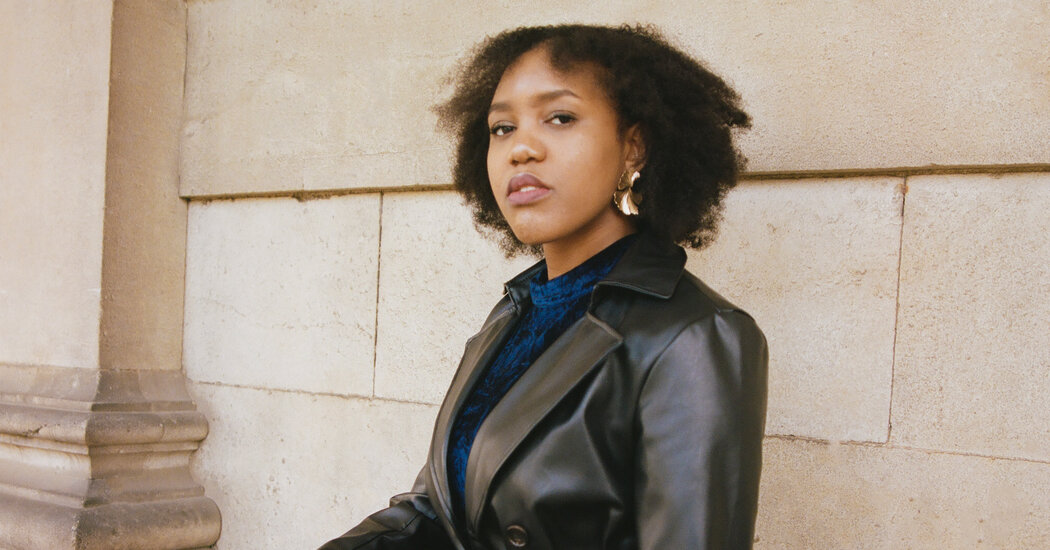
During a visit to a villa in Naples, Italy, Glory Samjolly cajoled her sister and a friend to engage in a witty form of cosplay. Posed regally in a period pastiche of men’s brocade vests, neck ruffs, knee breeches and lavishly embroidered frock coats, they were captured by Ms. Samjolly in a group portrait, its playfully subversive title, “The Honorable Women of Slayage in their study.”
For all its pomp and vibrancy, the painting might have gone unnoticed, except that the artist and her other two subjects were Black.
The piece is provocative, but for Ms. Samjolly, a 24-year-old figurative artist and self-professed feminist, provocation is the point.
Her paintings were conceived as a retort to the dearth of Black nobles in historical European portraiture, she said in an interview from her home in London. It has been and still is “such a rarity to find Afro-Europeans who aren’t slaves or shown as servants in the background of a painting, or featured as decoration,” said Ms. Samjolly, who studied fine arts at the University of the Arts London. “I asked myself, ‘Hang on, where is the rest of this work?’”
Hard-pressed to find it, she decided to create her own oil portraits of contemporary artists, business owners, writers and intellectuals in costumes and settings evocative of the European Masters. Some, though not all, are friends willing to sit for Ms. Samjolly who paints them in oils against a period background, pressing her floridly ornamental effects onto the canvas through a process called oil transfer. (She sells prints of her paintings through her website.)
Strategically in tune with the times, she soon began scouring the internet for historical works to serve as inspiration. She posted them on her Instagram account, “Blackaristocratart,” replete with lofty Afro-European figures of stature and nobility customarily overlooked by art historians.
“I want to bring to the forefront these characters who were footnotes in history,” she said of her posts, adding: “They are one way of reconstructing the way that Black and ethnic people view themselves.”
Her Instagram gallery — she is planning to find a physical space to house blow-ups of those images — includes Dmitry Levitzky’s late-1700s portrait of Ivan Gannibal, an eminent military leader and the great-uncle of the Russian poet Alexander Pushkin, and a portrait of Pushkin himself, who is thought by some scholars to be of African descent.
Alessandro de’ Medici, the ruler of Florence in the mid-1500s, appears, as does Dido Elizabeth Belle, the daughter of a British naval captain and a slave, who grew up alongside her white cousin, Lady Elizabeth Murray, in the lavish surroundings of Kenwood House in Hampstead.
Her Instagram posts, which focus on contemporary figures as well, did not arise in a pop culture vacuum. In “Sanditon,” a Jane Austen adaptation streaming on PBS, Crystal Clarke portrays an Antiguan heiress of mixed descent. The cast of “Bridgerton” is led by Golda Rosheuvel as Queen Charlotte, a character based on a historical noble believed to be of mixed heritage. (A planned prequel will focus on Queen Charlotte’s coming-of-age.) And there is “The Gilded Age,” the HBO series, with Denée Benton as Peggy Scott as an aspiring writer whose well-to-do parents live with servants of their own.
Ms. Samjolly is not the first contemporary artist to deploy as a theme the gaping hole in representation. She cites among her influences works by Yinka Shonibare, a Nigerian painter and sculptor who explores issues of race and class; the American Kehinde Wiley, whose heroic portraits are an extravagant nod to the Masters; and Fabiola Jean-Louis, a Haitian who drapes an imaginary Afro-European nobility in period dress.
The concept of a Black elite has long engaged scholars. Among the more recent is Olivette Otele, a professor of the history of slavery at the University of Bristol in England and the author of “African Europeans: An Untold History,” which documents the rise of historical figures including the Afro-Dutch minister Jacobus Capitein and Johannes Maurus, the 13th-century Lord Chamberlain for the Kingdom of Sicily.
Christina Proenza-Coles, in her book “American Founders,” studied Black contributions to the shaping of the New World, writing that during the 19th century, “Afro-Americans actively negotiated the terms of republicanism and citizenship,” as doctors, lawyers, military leaders and political activists.
But it is the visual representation of such elevated figures that resonates most keenly with Ms. Samjolly, whose paintings were exhibited late last year at Kirby Hall, in Northamptonshire and, again, last December, at Circolo, a Gucci pop-up space in Shoreditch in east London.
She still likes portraying herself and her friends tricked out in period finery.
“I love the lavishness and sparkle of classical art,” she said. “I ask myself, ‘What if I actually were one of these portraits? What would I have looked like living in that time?’”
The answer has been elusive, since, as she noted, the few women of color who do appear in historical portraiture “are often very humble and without much charisma.
“I plan on changing that.”






